Zinc finger protein tristetraprolin interacts with CCL3 mRNA and regulates tissue inflammation
- PMID: 21784977
- PMCID: PMC3159726
- DOI: 10.4049/jimmunol.1101149
Zinc finger protein tristetraprolin interacts with CCL3 mRNA and regulates tissue inflammation
Abstract
Zinc finger protein tristetraprolin (TTP) modulates macrophage inflammatory activity by destabilizing cytokine mRNAs. In this study, through a screen of TTP-bound mRNAs in activated human macrophages, we have identified CCL3 mRNA as the most abundantly bound TTP target mRNA and have characterized this interaction via conserved AU-rich elements. Compared to the wild-type cells, TTP(-/-) macrophages produced higher levels of LPS-induced CCL3. In addition, the plasma level of CCL3 in TTP(-/-) mice was markedly higher than that in wild-type mice. To determine the in vivo significance of TTP-regulated CCL3, we generated CCL3(-/-)TTP(-/-) double-knockout mice. Along with decreased proinflammatory cytokines in their paw joints, there were significant functional and histologic improvements in the inflammatory arthritis of TTP(-/-) mice when CCL3 was absent, although cachexia, reflecting systemic inflammation, was notably unaffected. Furthermore, the marked exacerbation of aortic plaque formation caused by TTP deficiency in the APOE(-/-) mouse model of atherosclerosis was also rescued by disrupting CCL3. Taken together, our data indicate that the interaction between TTP and CCL3 mRNA plays an important role in modulating localized inflammatory processes in tissues that are dissociated from the systemic manifestations of chronic inflammation.
Figures
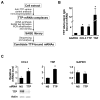
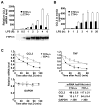
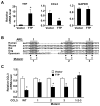
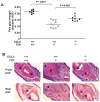
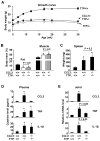

Similar articles
-
Tristetraprolin Limits Inflammatory Cytokine Production in Tumor-Associated Macrophages in an mRNA Decay-Independent Manner.Cancer Res. 2015 Aug 1;75(15):3054-64. doi: 10.1158/0008-5472.CAN-15-0205. Epub 2015 Jul 16. Cancer Res. 2015. PMID: 26183929 Free PMC article.
-
Tristetraprolin-driven regulatory circuit controls quality and timing of mRNA decay in inflammation.Mol Syst Biol. 2011 Dec 20;7:560. doi: 10.1038/msb.2011.93. Mol Syst Biol. 2011. PMID: 22186734 Free PMC article.
-
Enhanced stability of tristetraprolin mRNA protects mice against immune-mediated inflammatory pathologies.Proc Natl Acad Sci U S A. 2016 Feb 16;113(7):1865-70. doi: 10.1073/pnas.1519906113. Epub 2016 Feb 1. Proc Natl Acad Sci U S A. 2016. PMID: 26831084 Free PMC article.
-
Clinical implications of tristetraprolin (TTP) modulation in the treatment of inflammatory diseases.Pharmacol Ther. 2022 Nov;239:108198. doi: 10.1016/j.pharmthera.2022.108198. Epub 2022 May 5. Pharmacol Ther. 2022. PMID: 35525391 Free PMC article. Review.
-
The tandem CCCH zinc finger protein tristetraprolin and its relevance to cytokine mRNA turnover and arthritis.Arthritis Res Ther. 2004;6(6):248-64. doi: 10.1186/ar1441. Epub 2004 Oct 8. Arthritis Res Ther. 2004. PMID: 15535838 Free PMC article. Review.
Cited by
-
The RNA-binding protein Tristetraprolin (TTP) is a critical negative regulator of the NLRP3 inflammasome.J Biol Chem. 2017 Apr 28;292(17):6869-6881. doi: 10.1074/jbc.M116.772947. Epub 2017 Mar 16. J Biol Chem. 2017. PMID: 28302726 Free PMC article.
-
Integrated analysis of single-cell RNA sequencing and bulk RNA data reveals gene regulatory networks and targets in dilated cardiomyopathy.Sci Rep. 2024 Jun 17;14(1):13942. doi: 10.1038/s41598-024-64693-2. Sci Rep. 2024. PMID: 38886541 Free PMC article.
-
Tristetraprolin Overexpression in Non-hematopoietic Cells Protects Against Acute Lung Injury in Mice.Front Immunol. 2020 Sep 2;11:2164. doi: 10.3389/fimmu.2020.02164. eCollection 2020. Front Immunol. 2020. PMID: 32983182 Free PMC article.
-
Early TCR Signaling Induces Rapid Aerobic Glycolysis Enabling Distinct Acute T Cell Effector Functions.Cell Rep. 2018 Feb 6;22(6):1509-1521. doi: 10.1016/j.celrep.2018.01.040. Cell Rep. 2018. PMID: 29425506 Free PMC article.
-
Widespread Effects of Chemokine 3' Untranslated Regions on mRNA Degradation and Protein Production in Human Cells.J Immunol. 2018 Aug 1;201(3):1053-1061. doi: 10.4049/jimmunol.1800114. Epub 2018 Jun 15. J Immunol. 2018. PMID: 29907706 Free PMC article.
References
-
- Anderson P. Post-transcriptional regulons coordinate the initiation and resolution of inflammation. Nat Rev Immunol. 2010;10:24–35. - PubMed
-
- Carballo E, Lai WS, Blackshear PJ. Feedback inhibition of macrophage tumor necrosis factor-alpha production by tristetraprolin. Science. 1998;281:1001–1005. - PubMed
-
- Taylor GA, Carballo E, Lee DM, Lai WS, Thompson MJ, Patel DD, Schenkman DI, Gilkeson GS, Broxmeyer HE, Haynes BF, Blackshear PJ. A pathogenetic role for TNF alpha in the syndrome of cachexia, arthritis, and autoimmunity resulting from tristetraprolin (TTP) deficiency. Immunity. 1996;4:445–454. - PubMed
Publication types
MeSH terms
Substances
Grants and funding
LinkOut - more resources
Full Text Sources
Molecular Biology Databases
Miscellaneous

